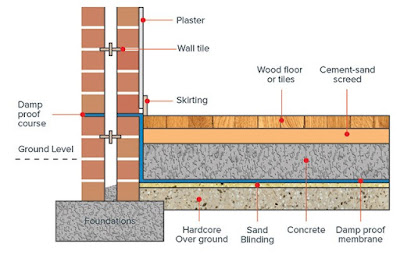 |
| Figure 1. Damp Proofing |
Damp Proofing: In order to prevent the entry of damp into a building, the courses, known as the damp-proofing courses, are provided at various levels of entry of damp into the building. The provision of damp-proofing courses prevents the entry of moisture from walls, floors and basement of a building.
Following methods are adopted to make a building damp proof:
1. Membrane Damp Proofing: This consists of introducing a water repellent membrane or damp proof course (D.P.C.) between the source of dampness and the part of building adjacent to it. Damp proof course may consist of flexible materials such as bitumen, mastic asphalt, bituminous felts, plastic and polythene sheets, metal sheets, cement concrete, etc. Damp proofing course may be provided either horizontally or vertically in floors, walls, etc. The provision of D.P.C. in basement is normally termed as tanking.
The best location or position of D.P.C. in case of buildings without basement lies at the plinth level or in case of structures without plinth it should be laid at least 15 cm above the ground level.
2. Integral Damp Proofing: The integral treatment consists of adding certain compounds to the concrete or mortar during the process of mixing, which when used in construction, act as barriers to moisture penetration. Such compounds are available in market in powdered as well as liquid form.
The quantity of water proofing compound to be added to cement depends upon the manufacturers recommendations. in general one kg of water proofing compound is added with one bag of cement to render the mortar or concrete water proof.
The compounds like alkaline, silicates, aluminium sulphate and calcium chlorides react chemically and fill in the pores to act water resistant.
3. Water Proof Surface Treatment: The surface treatment consists of application of layer of water repellent substances or compounds on these surfaces through which moisture enters. The use of water repellent metallic soaps such as calcium and aluminium oleates and stearates is much effective in protecting the building against the ravages of heavy rain. Bituminous solution, cement coating,transparent coatings, painting and distempering fall under this category. In addition to other surface treatments given to walls, the one commonly used is lime cement plaster. The walls plastered with cement, lime and sand mixed in proportions of 1:1:6 is found to serve the purpose of preventing dampness in wall due to rain effectively.
4. Cavity Wall Construction: This is an effective method of damp prevention, in which the main wall of a building is shielded by an outer skin wall, leaving a cavity between the two.
A cavity wall consists of two parallel walls or leaves or skins of masonry separated by a continuous air space or cavity. Cavity walls consists of three main parts, namely
a) the outer wall or leaf (10 cm thick) which is the exterior part of the wall.
b) the cavity or air space of 5 cm to 8 cm, and
c) the inner wall or leaf (min 10 cm in thickness) which is the interior part of the wall.
The two leaves, forming a cavity in between, may be of equal thickness or the thickness of the inner leaf may be increased to take the greater proportion of the imposed loads transmitted by floor and roof. The provision of continuous cavity in the wall efficiently prevents the transmission or percolation of dampness from outer wall or leaf to the inner wall or leaf.
Cavity type of construction is most desirable as it offers many advantages such as better living and comfort conditions, construction economy and preservation of dampness and also offers good insulation against sound.
5. Guniting: The process of depositing under pressure, an impervious layer of rich cement mortar over the exposed surfaces for water proofing or over pipes, cisterns, etc., for resisting the water pressure. Cement mortar consists of 1:3 cement sand mix, which is shot on the cleaned surface with the help of a cement gun, under pressure of 2 to 3 kg/sq cm. The nozzle of the machine is kept at a distance about 75 to 90 cm from the surface to be gunited. The mortar mix of desired consistency and thickness can be deposited to get an impervious layer. The layer should be properly cured atleast for 10 days.
6. Pressure Grouting: This consists of forcing cement grout, under pressure, into cracks, voids, fissures, etc. present in the structural components of the building, or in the ground. Thus the structural components and the foundations which are liable to moisture penetration are consolidated and are thus made water-penetration-resistant. This method is quite effective in checking the seepage of raised ground water through foundations and substructure of a building.
Great blog on HDPE sheets! These sheets are essential for damp proofing due to their excellent water resistance and durability. HDPE sheets provide a reliable barrier against moisture, making them perfect for construction and industrial use. As HDPE sheet manufacturers in Gujarat, we offer high-quality, cost-effective solutions for damp proofing.
ReplyDelete